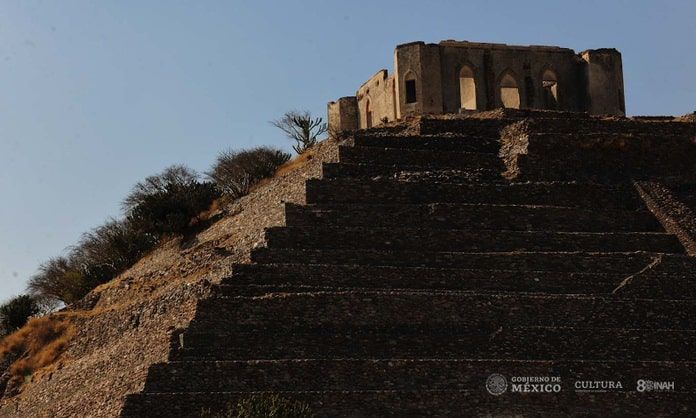El Cerrito archaeological zone: a sacred site to this day
A few minutes from the city of Queretaro, in the municipality of Corregidora, El Cerrito has become part of the state's tourist corridor in recent years. A sacred site to this day.

A singular archaeological zone deeply linked to the future of Queretaro is El Cerrito, among its peculiarities is El Fortin, a historical monument from the 19th century that tops its pyramidal base, a unique case among the pre-Hispanic sites in the country, not to mention that it was the original shrine of the miraculous Virgin of El Pueblito, for a little more than a century.
A few minutes from the city of Queretaro, in the municipality of Corregidora, El Cerrito has become part of the state's tourist corridor in recent years. This growing interest can enhance the tour to other sites in the municipality, among them, the sanctuary of the Virgin of El Pueblito (Patron Saint of Querétaro) around which numerous pilgrimages and popular festivals are held, such as The Ox Walk, in February, in which the transfer of the small sculpture (made with Purepecha techniques and materials) to the aforementioned temple is commemorated.
In itself, El Cerrito was an important ceremonial center, of Toltec filiation, located in the south of the Valley of Querétaro and part of a series of settlements in this zone of the Altiplano that were also linked to the Bajío. It has elements, both architectural and movable goods, that show an occupation towards the Epiclassic and Early Postclassic (700-900 A.D./ 900-1200 A.D.).
Subsequently, this space is preserved by Chichimec groups, of agricultural affiliation, not hunter-gatherers, around 1,200 A.D., after the fall of Tula. The interesting thing about this Chichimec occupation, which lasted until the 16th century, is that it respected the original limits of the ceremonial center established by the groups linked to the Toltec culture.
An important conclusion about the first occupation of El Cerrito, which seemed to point to links with Teotihuacan, was that the people here only imitated the forms of Teotihuacan ceramics since there are no architectural remains that demonstrate a greater presence.
The Pyramidal Basement of El Cerrito, seated in a natural rock outcrop, reaches a height of 30 meters -similar to that of the Pyramid of Luna in Teotihuacan- and in its base, it has 118 meters per side. To this structure are added the Dance and Sculpture plazas, the Altar of Skulls, and the Palace of the Four Altars.
One of the most important discoveries, recovered at the end of 1998 in the southern part of the main pyramid (inside the Plaza of the Sculptures, near the Altar of Skulls), was a child burial, the only complete one located so far. It corresponds to a child between 5 and 7 years of age, associated with the last pre-Hispanic occupations, between 1200 and 1500 AD.
A sacred site to this day
El Cerrito exists within the collective memory of the population. There is a reference that when El Pueblito was founded on a pre-Hispanic settlement, it was under the name of San Francisco Galileo, an Otomi-Chichimeca-speaking population. In the Relación geográfica de Querétaro, from the end of the 16th century, a site called San Francisco Anbanicá ("In the high temple", in Otomí) is mentioned, which was most probably El Cerrito.
By the 18th century the site was explored by Fray Juan Agustín de Morfi, however, previously a Capuchin priest, Francisco Ajofrín, who was looking for alms to maintain the missions in Tibet, made in 1774 a drawing of the pyramidal base about the sanctuary of the Virgin of El Pueblito.
The history of the Virgin of El Pueblito has to do much with the functioning of the archaeological zone because by 1632 the indigenous population still placed offerings in this place, then, the Franciscans replaced this cult by placing an image of the Virgin Mary in her invocation of the Immaculate Conception.
For more than a century the Virgin of El Pueblito was venerated in El Cerrito until it was moved to the sanctuary in 1735. Today, the sculpture is still taken to the archaeological zone, but every five years, in October, the local people pray to her at night.
Why El Cerrito?
El Cerrito was vulnerable to looting and erosion after the virgin was moved. Because the construction system is made of stone with earth, maintained only by a stucco covering, its core was exposed and vegetation grew over the structure, giving the appearance of a small hill ("Cerrito") for more than two centuries.
Likewise, the archaeological zone belonged to the grounds of the Hacienda 'El Cerrito'. The construction on top of the pyramidal base is a house built in 1876 by the then owner of the hacienda, with a curious architectural concept: a military-style floor plan, with neo-Gothic doors and windows. All this makes the archaeological zone of El Cerrito unique.




